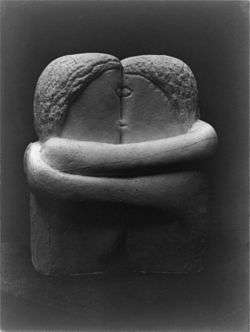The Kiss (Brâncuși sculpture)
The Kiss (in Romanian: Sărutul /səruːtul/) is a sculpture by Romanian Modernist sculptor Constantin Brâncuși. It is an early example of his proto-cubist style of non-literal representation.
| The Kiss | |
|---|---|
| French: Le Baiser | |
 | |
| Artist | Constantin Brâncuși |
| Year | 1907-08 |
| Type | Plaster sculpture |
| Dimensions | 27.9 x 26 x 21.6 cm (11 x 10.25 x 8.5 in) |
| Location | Possibly the Rockefeller-Latner cast |
This plaster was exhibited at the 1913 Armory Show and published in the Chicago Tribune of 25 March 1913.[1] This early plaster sculpture is one of six casts that Brancusi made of the 1907–08 The Kiss.
- Versions
The original stone carving is in the Muzeul de Arta at Craiova, Romania.[2]
Brâncuși created many versions of The Kiss, further simplifying geometric forms and sparse objects in each version, tending each time further toward abstraction.[3] His abstract style emphasizes simple geometrical lines that balance forms inherent in his materials with the symbolic allusions of representational art. Here, the shape of the original block of material is maintained. Another version of The Kiss serves as an adornment of a tomb in Montparnasse cemetery in Paris, France but has since August 2017 been covered up in a box.[4]
[5] Another version still can be seen at the Philadelphia Museum of Art.[6]
This version of The Kiss is one of the artist's most well known works, along with Sleeping Muse (1908), Prometheus (1911), Mademoiselle Pogany (1913), The Newborn (1915), Bird in Space (1919) and The Column of the Infinite (Coloana infinitului), known as The Endless Column (1938).
References
- Walt Kuhn scrapbook of press clippings documenting the Armory Show, vol. 2, 1913, Page 96, published Chicago Tribune, 25 March 1913 (the published cropped image is the same photograph reproduced here)
- The Kiss, Nasher Sculpture Center
- BBC News, review: Brancusi at the Tate Retrieved January 13, 2011
- In a Parisian Cemetery, a Lovely Brancusi Has Vanished in Plain Sight at Hyperallergic
- BBC, The Kiss, Montparnasse cemetery
- Philadelphia Museum of Art version
- "Constantin Brancusi, The Kiss". Smarthistory at Khan Academy. Retrieved September 27, 2015.